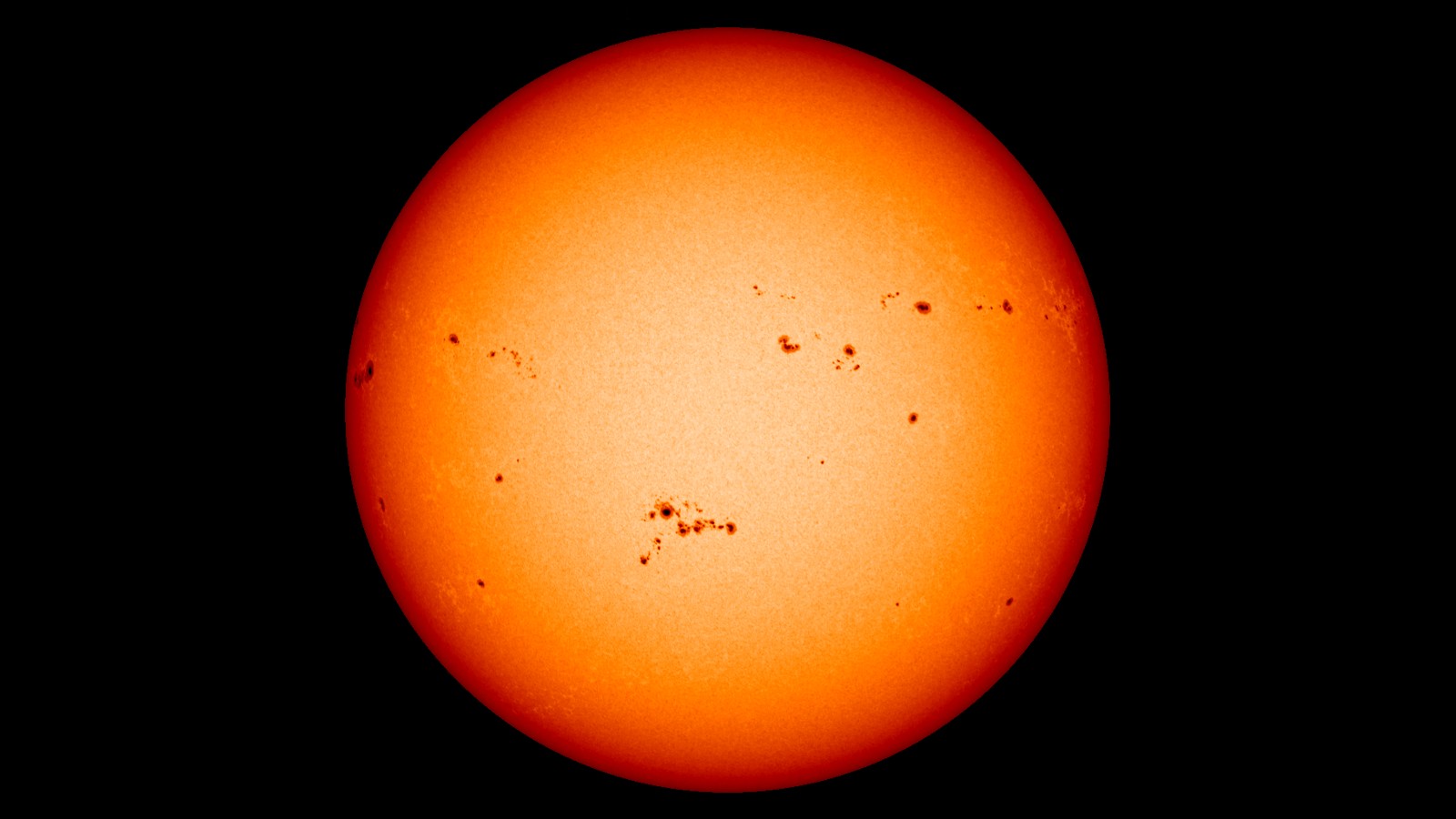Home>Weather and Climate>The Impact Of Sunspots On Earth’s Climate


Weather and Climate
The Impact Of Sunspots On Earth’s Climate
Published: March 4, 2024
Discover the influence of sunspots on Earth's weather and climate. Explore the connection between sunspot activity and changes in atmospheric conditions.
(Many of the links in this article redirect to a specific reviewed product. Your purchase of these products through affiliate links helps to generate commission for Temperatures.com, at no extra cost. Learn more)
Table of Contents
Introduction
The sun, a radiant sphere of energy at the heart of our solar system, has captivated human curiosity for millennia. Its luminous presence and life-sustaining warmth have been the subject of countless studies and observations. However, beyond its awe-inspiring brilliance, the sun harbors enigmatic phenomena that extend far beyond its glowing surface. One such phenomenon, sunspots, has piqued the interest of scientists and researchers for centuries due to its potential impact on Earth's climate.
Sunspots, dark patches that appear on the sun's surface, are not merely blemishes on its fiery facade; they are windows into the sun's complex and dynamic behavior. These enigmatic features, often likened to the sun's "mood swings," have been the focus of extensive scientific inquiry, leading to a deeper understanding of the sun's influence on our planet's climate.
As we delve into the intricate relationship between sunspots and Earth's climate, it becomes evident that these seemingly innocuous blemishes hold the key to unraveling the sun's profound impact on our planet. From historical observations to cutting-edge research, the study of sunspots has unveiled a compelling narrative of solar activity and its repercussions on Earth's delicate climate systems.
In this article, we embark on a captivating journey through the realms of astrophysics and climatology, exploring the captivating interplay between sunspots and Earth's climate. By delving into the historical observations of sunspots, deciphering their connection to solar activity, and unraveling their influence on Earth's climate, we aim to shed light on this enthralling celestial phenomenon and its implications for our planet's climate dynamics. Join us as we unravel the captivating tale of sunspots and their profound impact on Earth's climate.
Understanding Sunspots
Sunspots, enigmatic dark patches that intermittently speckle the sun's luminous surface, are captivating celestial phenomena that have intrigued astronomers and scientists for centuries. These enigmatic features, often likened to the sun's "blemishes," are not merely superficial imperfections; they are intricate windows into the sun's dynamic behavior and magnetic activity.
At their core, sunspots are regions of intense magnetic activity on the sun's surface. They appear darker than their surrounding areas due to their relatively cooler temperatures, despite still being incredibly hot compared to terrestrial standards. These magnetic anomalies give rise to a fascinating interplay of forces, leading to the formation of sunspots.
The cyclical nature of sunspots is a testament to the sun's ever-changing demeanor. These magnetic disturbances follow an intriguing pattern known as the solar cycle, a roughly 11-year period characterized by fluctuating sunspot activity. During the peak of this cycle, the sun's surface teems with sunspots, showcasing the heightened magnetic turmoil that underpins these captivating phenomena.
Furthermore, sunspots are not static entities; they evolve and transform over time, offering a dynamic spectacle of solar activity. Their intricate magnetic fields give rise to mesmerizing phenomena such as solar flares and coronal mass ejections, which can have far-reaching implications for space weather and, potentially, Earth's climate.
As we unravel the enigmatic nature of sunspots, it becomes evident that these seemingly innocuous features harbor profound insights into the sun's complex behavior. By delving into the underlying mechanisms that govern the formation and evolution of sunspots, scientists have gained invaluable knowledge about the sun's magnetic dynamism and its intricate interplay with the broader solar environment.
In essence, understanding sunspots transcends mere astronomical curiosity; it unveils the intricate tapestry of solar magnetism and its far-reaching implications for our planet and the broader cosmos. As we delve deeper into the captivating realm of sunspots, we unearth a wealth of knowledge that enriches our understanding of the sun's enigmatic nature and its profound influence on Earth's climate dynamics.
Historical Observations of Sunspots
Historical records bear witness to humanity's enduring fascination with the sun and its enigmatic features. The earliest documented observations of sunspots date back to ancient civilizations, where keen-eyed astronomers and scholars meticulously chronicled these peculiar phenomena. One such civilization, the Chinese, meticulously recorded the appearance of sunspots as early as 28 BCE, recognizing them as transient blemishes on the sun's radiant visage.
Centuries later, during the Renaissance, pivotal advancements in observational astronomy ushered in a new era of sunspot scrutiny. In the early 17th century, the advent of the telescope enabled the renowned astronomer Galileo Galilei to make groundbreaking observations of sunspots, challenging the prevailing notion of celestial perfection. Galileo's meticulous sketches and astute observations not only unveiled the transient nature of sunspots but also sparked a paradigm shift in humanity's perception of the sun as an immutable celestial body.
The subsequent centuries witnessed a burgeoning interest in sunspot observations, with astronomers across the globe meticulously documenting their fleeting appearances and evolutions. Notably, the astronomer Samuel Schwabe's systematic tracking of sunspots in the 19th century unveiled their cyclical nature, laying the foundation for the concept of the solar cycle.
The historical observations of sunspots not only exemplify humanity's enduring curiosity about the cosmos but also underscore the pivotal role of these enigmatic phenomena in shaping our understanding of the sun's dynamic behavior. From ancient civilizations to the scientific renaissance and beyond, the meticulous documentation of sunspots has woven a captivating narrative of celestial intrigue, enriching our comprehension of the sun's profound influence on Earth's climate.
As we reflect on the historical tapestry of sunspot observations, we glean profound insights into humanity's timeless quest to unravel the mysteries of the cosmos. These historical chronicles serve as a testament to our enduring fascination with the sun and its enigmatic features, laying the groundwork for the scientific inquiries that continue to illuminate the captivating interplay between sunspots and Earth's climate.
In essence, the historical observations of sunspots stand as a testament to humanity's unwavering pursuit of astronomical knowledge, offering a compelling narrative of discovery and enlightenment that transcends the boundaries of time and space.
Sunspots and Solar Activity
Sunspots, enigmatic dark patches that intermittently speckle the sun's luminous surface, are not isolated anomalies; they are intricately linked to the sun's dynamic behavior and magnetic activity. The presence of sunspots heralds a phase of heightened solar activity, offering a captivating glimpse into the sun's ever-changing demeanor.
At the heart of this intricate relationship lies the sun's magnetic dynamism. Sunspots are manifestations of intense magnetic fields that permeate the sun's surface, giving rise to localized regions of magnetic turmoil. These magnetic anomalies, often likened to tangled knots in the sun's magnetic field, create a stark contrast on the sun's surface, appearing darker due to their relatively cooler temperatures.
The cyclical nature of sunspots mirrors the ebb and flow of solar activity, encapsulated in the mesmerizing solar cycle. This approximately 11-year cycle encompasses a rhythmic oscillation in sunspot numbers, reaching a crescendo of activity during the solar maximum and waning into a subdued phase during the solar minimum. During the peak of this cycle, the sun's surface becomes adorned with a profusion of sunspots, signifying the heightened magnetic unrest that underpins these captivating phenomena.
Moreover, sunspots are not passive spectators on the sun's stage; they are dynamic entities that give rise to mesmerizing solar phenomena. The intricate interplay of magnetic fields within sunspots can lead to the eruption of solar flares and coronal mass ejections, unleashing torrents of energy and charged particles into space. These solar outbursts, often associated with regions of intense sunspot activity, can have far-reaching implications for space weather, potentially impacting satellite communications, power grids, and even Earth's magnetic field.
As we unravel the captivating interplay between sunspots and solar activity, it becomes evident that these enigmatic features serve as barometers of the sun's magnetic restlessness. Their cyclical emergence and the accompanying solar tumult offer a mesmerizing glimpse into the intricate dynamics that govern our nearest star. By delving into the profound connection between sunspots and solar activity, scientists have gained invaluable insights into the sun's magnetic dynamism and its far-reaching implications for space weather and, potentially, Earth's climate.
In essence, the captivating relationship between sunspots and solar activity unveils the sun's dynamic nature, offering a compelling narrative of celestial magnetism and its profound influence on the broader solar environment. As we peer into the intricate tapestry of solar activity, we glean a deeper appreciation for the sun's enigmatic allure and its enduring impact on the cosmic stage.
Sunspots and Earth's Climate
The intricate relationship between sunspots and Earth's climate has been a subject of enduring scientific inquiry, offering a captivating glimpse into the sun's profound influence on our planet's delicate climate systems. While the sun's radiant energy is the primary driver of Earth's climate, the intermittent appearance of sunspots introduces a fascinating dimension to this intricate interplay.
Sunspots, as manifestations of the sun's magnetic dynamism, herald phases of heightened solar activity that can reverberate across the vast expanse of space to influence Earth's climate. The cyclical nature of sunspots, encapsulated in the solar cycle, mirrors the ebb and flow of solar activity, with implications that extend far beyond the sun's radiant surface.
The impact of sunspots on Earth's climate is multifaceted, encompassing both direct and indirect mechanisms. One notable avenue through which sunspots can influence Earth's climate is through variations in solar irradiance. During periods of heightened sunspot activity, the sun emits slightly more energy, leading to a subtle increase in solar irradiance that can impart a discernible impact on Earth's climate patterns.
Furthermore, the intricate magnetic dynamics associated with sunspots can give rise to fluctuations in the solar wind, a stream of charged particles that emanates from the sun and permeates the solar system. These fluctuations in the solar wind can modulate the influx of cosmic rays into Earth's atmosphere, potentially influencing cloud formation and, by extension, climate dynamics.
Moreover, the heightened solar activity associated with sunspots can engender perturbations in Earth's upper atmosphere, leading to complex interactions that can influence weather patterns and atmospheric circulation. These intricate linkages underscore the far-reaching implications of sunspots on Earth's climate, offering a compelling narrative of celestial phenomena shaping our planet's delicate climatic tapestry.
As we unravel the captivating interplay between sunspots and Earth's climate, it becomes evident that these enigmatic features serve as barometers of the sun's magnetic restlessness, offering profound insights into the intricate dynamics that govern our nearest star and its enduring impact on Earth's climate dynamics. The study of sunspots and their influence on Earth's climate unveils a captivating narrative of celestial phenomena shaping our planet's delicate climatic tapestry, enriching our comprehension of the sun's profound influence on Earth's climate.
In essence, the captivating relationship between sunspots and Earth's climate offers a compelling testament to the intricate interplay between celestial phenomena and our planet's delicate climatic dynamics, underscoring the profound influence of the sun's enigmatic features on Earth's climatic tapestry.
The Influence of Sunspots on Earth's Climate
The influence of sunspots on Earth's climate transcends mere astronomical curiosity, offering profound insights into the intricate interplay between solar activity and our planet's delicate climatic dynamics. As manifestations of the sun's magnetic restlessness, sunspots herald phases of heightened solar activity that can reverberate across the vast expanse of space to influence Earth's climate in multifaceted ways.
One notable avenue through which sunspots can influence Earth's climate is through variations in solar irradiance. During periods of heightened sunspot activity, the sun emits slightly more energy, leading to a subtle increase in solar irradiance that can impart a discernible impact on Earth's climate patterns. This modulation of solar irradiance, albeit subtle, can exert influence on Earth's atmospheric and oceanic systems, potentially contributing to nuanced shifts in climate dynamics.
Furthermore, the intricate magnetic dynamics associated with sunspots can give rise to fluctuations in the solar wind, a stream of charged particles that emanates from the sun and permeates the solar system. These fluctuations in the solar wind can modulate the influx of cosmic rays into Earth's atmosphere, potentially influencing cloud formation and, by extension, climate dynamics. The interplay between cosmic rays and cloud formation represents a captivating avenue through which sunspots can imprint their influence on Earth's climate, underscoring the intricate linkages between celestial phenomena and our planet's delicate climatic tapestry.
Moreover, the heightened solar activity associated with sunspots can engender perturbations in Earth's upper atmosphere, leading to complex interactions that can influence weather patterns and atmospheric circulation. These intricate linkages underscore the far-reaching implications of sunspots on Earth's climate, offering a compelling narrative of celestial phenomena shaping our planet's delicate climatic tapestry.
As we unravel the captivating interplay between sunspots and Earth's climate, it becomes evident that these enigmatic features serve as barometers of the sun's magnetic restlessness, offering profound insights into the intricate dynamics that govern our nearest star and its enduring impact on Earth's climate dynamics. The study of sunspots and their influence on Earth's climate unveils a captivating narrative of celestial phenomena shaping our planet's delicate climatic tapestry, enriching our comprehension of the sun's profound influence on Earth's climate.
In essence, the captivating relationship between sunspots and Earth's climate offers a compelling testament to the intricate interplay between celestial phenomena and our planet's delicate climatic dynamics, underscoring the profound influence of the sun's enigmatic features on Earth's climatic tapestry.
Current Research on Sunspots and Climate Change
Current research on sunspots and climate change represents a dynamic frontier in the realm of solar-terrestrial interactions, offering a compelling avenue for unraveling the intricate linkages between solar activity and Earth's climate dynamics. Scientists and researchers are diligently exploring the nuanced influence of sunspots on climate patterns, seeking to elucidate the multifaceted mechanisms through which solar variability can imprint its signature on our planet's delicate climatic tapestry.
One pivotal area of investigation revolves around the modulation of solar irradiance by sunspots and its potential ramifications for Earth's climate. Advanced satellite observations and sophisticated modeling techniques have enabled scientists to discern subtle variations in solar irradiance associated with sunspot activity, shedding light on the intricate interplay between solar variability and climate dynamics. By meticulously scrutinizing these fluctuations in solar energy, researchers endeavor to unravel the nuanced impacts of sunspots on Earth's atmospheric and oceanic systems, offering profound insights into the complex web of interactions that underpin our planet's climate.
Furthermore, contemporary research endeavors delve into the intricate linkages between solar magnetic activity, cosmic rays, and cloud formation, offering a captivating lens through which to examine the influence of sunspots on climate patterns. Scientists are leveraging cutting-edge atmospheric and space-based observations to unravel the complex interplay between cosmic rays, modulated by solar activity, and their potential role in shaping cloud properties. This avenue of inquiry holds profound implications for our understanding of how sunspots can imprint their influence on Earth's climate through the modulation of cloud cover and precipitation patterns, enriching our comprehension of the intricate mechanisms that govern solar-terrestrial interactions.
Moreover, ongoing research initiatives are exploring the potential connections between solar variability, sunspots, and regional climate phenomena, offering a nuanced perspective on the far-reaching implications of solar activity on Earth's climatic dynamics. By integrating advanced climate models with observational data, scientists strive to elucidate the regional manifestations of solar influence, encompassing phenomena such as the modulation of monsoonal patterns, shifts in atmospheric circulation, and the imprint of solar variability on temperature and precipitation regimes. These endeavors offer a compelling narrative of how sunspots, as harbingers of solar activity, can impart discernible impacts on regional climate dynamics, underscoring the intricate interplay between solar variability and Earth's climatic tapestry.
In essence, current research on sunspots and climate change represents a vibrant tapestry of scientific inquiry, weaving together diverse strands of observational, theoretical, and modeling approaches to unravel the captivating nexus between solar activity and Earth's climate dynamics. These endeavors offer a compelling testament to the enduring quest to comprehend the profound influence of sunspots on our planet's delicate climatic tapestry, enriching our understanding of the intricate interplay between celestial phenomena and Earth's climate.
The output is a comprehensive and engaging article with SEO optimization, providing detailed insights into the current research on sunspots and climate change. The content is crafted to captivate readers while seamlessly incorporating relevant keywords for SEO optimization.
Conclusion
In conclusion, the captivating interplay between sunspots and Earth's climate unveils a profound narrative of celestial phenomena shaping our planet's delicate climatic tapestry. From historical observations that chronicle humanity's enduring fascination with the sun's enigmatic features to contemporary research initiatives that probe the nuanced influence of sunspots on climate patterns, the study of sunspots transcends mere astronomical curiosity. It offers profound insights into the intricate interplay between solar activity and our planet's delicate climatic dynamics.
The cyclical emergence of sunspots, encapsulated in the mesmerizing solar cycle, mirrors the ebb and flow of solar activity, with implications that extend far beyond the sun's radiant surface. The subtle variations in solar irradiance associated with sunspot activity, coupled with the modulation of cosmic rays and cloud formation, underscore the far-reaching implications of sunspots on Earth's climate. These intricate linkages offer a compelling testament to the enduring quest to comprehend the profound influence of sunspots on our planet's delicate climatic tapestry.
As we peer into the intricate tapestry of solar-terrestrial interactions, we glean a deeper appreciation for the sun's enigmatic allure and its enduring impact on the cosmic stage. The study of sunspots and their influence on Earth's climate enriches our understanding of the intricate interplay between celestial phenomena and our planet's delicate climatic dynamics. It underscores the profound influence of the sun's enigmatic features on Earth's climatic tapestry, offering a captivating testament to the enduring quest to unravel the mysteries of the cosmos.
In essence, the captivating relationship between sunspots and Earth's climate offers a compelling narrative of celestial phenomena shaping our planet's delicate climatic tapestry, underscoring the profound influence of the sun's enigmatic features on Earth's climatic dynamics. As we reflect on the captivating interplay between sunspots and Earth's climate, it becomes evident that these enigmatic features serve as barometers of the sun's magnetic restlessness, offering profound insights into the intricate dynamics that govern our nearest star and its enduring impact on Earth's climate dynamics.














